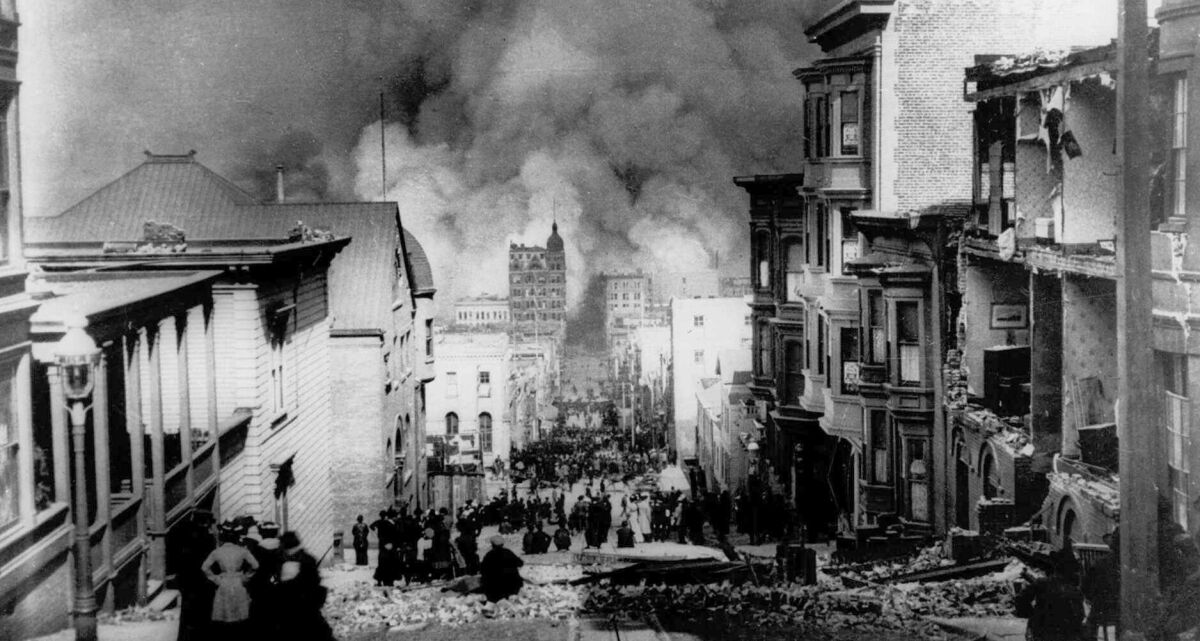On April 18, 1906, San Francisco phonograph dealer Peter Bacigalupi’s day began like none other.
“I was awakened from a sound slumber by a terrific trembling, which acted in the same manner as would a bucking broncho [sic],” he wrote of the historic earthquake that seemed to toss his bed “up and down in all four directions at once.”
Across town, missionary Donaldina Cameron jolted awake at 5:12 a.m. to a surreal scene in which “the solid earth took on the motions of an angry ocean while chimneys crashed on to our roof, while plaster and ornaments strewed the floors.”
Bacugalupi and Cameron survived to tell their stories of California’s deadliest natural disaster. An estimated 3,000 people in the San Francisco Bay Area did not.
Newsletter
Get earthquake-ready in six weeks
From building a kit to buying insurance, our Unshaken newsletter course will help you prepare.
You may occasionally receive promotional content from the Los Angeles Times.
Though definitive measurements weren’t available at the time, the magnitude 7.8 disaster is believed to have been a particular type of earthquake known as a supershear.
In a supershear quake, the fault — in the 1906 case, the San Andreas — ruptures faster than seismic shear waves can travel through rock. The result is an accumulation of energy that bursts through rock in the way that sound waves piling up against a speeding fighter jet erupt in a sonic boom.

People watch smoke billowing from fires after a severe earthquake hit San Francisco April 18, 1906.
(Associated Press)
Supershear earthquakes were thought to be relatively rare, with fewer than a dozen such events confirmed and six others debated since 1906.
But new research from UCLA finds that this type of violent earthquake is more common than previously believed, particularly along mature strike-slip faults like the San Andreas.
Using advanced imaging technology, a research team led by UCLA geophysicist Lingsen Meng examined all 86 earthquakes of magnitude 6.7 or greater along strike-slip faults between Jan. 1, 2000, and Feb. 1, 2020. After analyzing each event, the team concluded that 14% of them were in fact supershear earthquakes — a considerable leap, given that supershears were previously believed to account for less than 6% of all earthquakes.
The findings were published last month in the journal Nature Geoscience.
“They’re applying these imaging methods really comprehensively to study many, many large earthquakes, most of which have not been studied with these advanced imaging methods,” said seismologist Eric Dunham, an expert in supershear earthquakes at Stanford University who was not involved with the research.
In the absence of tools that could effectively analyze fault ruptures on continents and oceanic crust alike, “we were just sort of guessing” at which events counted as supershear, Dunham said. “This paper shows that they may not be as rare as we thought.”
The San Francisco earthquake caused pavement and curbstones to buckle at the corner of 18th Street and Lexington Street.
(Associated Press)
Previously, seismologists suspected that this kind of earthquake occurred more often on continents than in faults running under the sea, since most confirmed supershears were recorded on land.
But using a technique called backprojection, which analyzes delays between seismic waves to determine how fast they are traveling, the team realized that supershear earthquakes are just as common in the ocean as on dry ground — they just have been historically a lot harder to monitor.
Their analysis found that in addition to five previously confirmed supershear earthquakes documented in their data set, a further seven also met the supershear criteria.
“I’m a little bit surprised we found this many,” Meng said of the newly identified supershear quakes, all of which took place along underwater fault lines beyond the reach of most land-based monitors.
Supershear earthquakes are more likely to happen along long, mature faults like the San Andreas, where many years of activity have ground away a lot of the twists and bumps that might slow down an earthquake’s energy.
In the same way that it’s easier to pick up speed on a long straight runway than on a winding road, a rupture will accelerate faster along a long, straight-ish fault than a snarled one, Meng said.
The strength of a supershear earthquake comes from the speed of that rupture. When sound waves accumulate in front of a jet moving faster than the speed of sound, they eventually merge into a single wave that a person on the ground hears as an explosion, or sonic boom.
And just as a sonic boom is louder than a typical engine’s roar, a supershear earthquake shakes harder.
“The same amount of energy released by the fault is being released in a shorter amount of time. So that always gives you a stronger shaking,” Meng said.
Current building codes are already designed to accommodate the possibility of a supershear-strength earthquake, said Elizabeth Cochran, a seismologist with the U.S. Geological Survey in Pasadena. But the violence of a supershear may be more likely to cause the secondary crises that cause so much devastation in a major quake, such as fires and landslides.
“It is a concern,” she said. “If you do have supershear rupture, you can then expect stronger shaking intensities, which then can translate into larger possibilities for damage.”
Only about 2% of the 28,000 buildings lost in the 1906 earthquake collapsed from the tremors. The vast majority were destroyed by raging fires after the tremors ruptured gas and water pipes. The strength of an earthquake matters, and so does what happens after the shaking stops.
